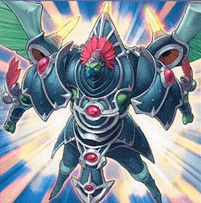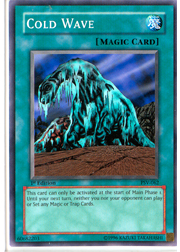 The thing that makes me sad about always writing about a deck that I’ve personally built is that it completely ignores the fact that the rest of our writers are more than capable of cranking out unique and awesome decks of their own. I would personally love to see the kind of stuff that Matt Peddle plays around with when he’s not working on his next trip to Day 2, or even the things he looks at as he is preparing. Every time I see Curtis at an event, he has a case full of decks that span the entirety of ways to win a duel. One of the most fun experiences I’ve had while travelling for a Shonen Jump Championship was dueling against Jason with each of us drawing a random deck from Curtis’s case and playing it without looking to see what it was first. Jason, on the other hand tends to try to stay one step ahead of the metagame, building his picks for the best decks in the format and then testing them out after Jumps. He’s come up with a number of really excellent decks, and I’m excited to be able to share one of them with you today.
The thing that makes me sad about always writing about a deck that I’ve personally built is that it completely ignores the fact that the rest of our writers are more than capable of cranking out unique and awesome decks of their own. I would personally love to see the kind of stuff that Matt Peddle plays around with when he’s not working on his next trip to Day 2, or even the things he looks at as he is preparing. Every time I see Curtis at an event, he has a case full of decks that span the entirety of ways to win a duel. One of the most fun experiences I’ve had while travelling for a Shonen Jump Championship was dueling against Jason with each of us drawing a random deck from Curtis’s case and playing it without looking to see what it was first. Jason, on the other hand tends to try to stay one step ahead of the metagame, building his picks for the best decks in the format and then testing them out after Jumps. He’s come up with a number of really excellent decks, and I’m excited to be able to share one of them with you today.
Going into the St. Louis weekend, there are three big decks that should be in every player’s gauntlet regardless of whether or not he or she is planning on playing the decks. Those decks are the new Dark Armed Dragon deck, fully powered Lightsworn (because who’s going to show up at a Jump without the full package?), and Gladiator Beasts with a focus on easy access to Gladiator Beast Gyzarus. To be honest, I was very surprised that Gladiator Beasts managed to take a Jump before reaching full power, and then not surprised at all when they failed to make any Day 2 appearances at the very next event in Nashville, even after the mid-format change in the Forbidden list. The Shonen Jump Championship Minneapolis showing seemed like Overdose had brought the right cards to the wrong party and that they were looking for the Jump on 5/10, not 4/12. Paul Levitin still won anyway, and knowing that Gladiator Beast Gyzarus was waiting in the wings convinced me that I needed to get a build together post-haste.
I discovered that Jason had beat me to the punch in every way, shape, and form , however, when he excitedly began describing a series of brutal plays that became possible thanks to Elemental Hero Prisma and Gladiator Beast Gyzarus. I feel like "filthy" is a good word for the kinds of things you can do with the Gladiator Beast deck now that we have access to both Gyzarus and Prisma, and that the power and speed of the post Light of Destruction Gladiator Beast deck really put the version that won in Minneapolis to shame. What would you rather do, play Shadow-Imprisoning Mirror or summon two of the best Fusions in the game without losing your overall card presence on turn 2?
One of the biggest advantages that Gladiator Beast players will have going into St. Louis is that few players in the event will have done their homework. They’ll still be attacking into face-down monsters on the first turn without taking Gladiator Beast Hoplomus into account, which can often turn an early blunder into a game-losing catastrophe. Your basic goal in the first two turns is to rob your opponent of as many cards as possible between Gyzarus and any other Gladiator Beast your opponent is kind enough to let you bring out. The most likely way that you’ll be getting a Gladiator Beast other than Gyzarus to the field is by your opponent swinging on a face-down Hoplomus without any way to pump over its massive DEF. Let’s face it: 2100 is a lot. The only deck out there that can get over that number consistently without committing its boss monster to the field is Lightsworn, and the ATK of the monster they’d be using (Celestia) is irrelevant because she’ll blow Hoplomus away when she’s tribute summoned. I find that the most common opening from a Dark Armed Dragon  deck against my set Hoplomus is the "summon Elemental Hero Stratos, do some stuff, and then ram Stratos into Hoplomus" play. Stratos still replaces himself with another Hero before being destroyed by Murmillo, but an open field in a format where Mirror Force doesn’t see play since it nearly never resolves is an invitation to attack. Just be careful not to get too greedy and fall right into a Torrential Tribute trap.
deck against my set Hoplomus is the "summon Elemental Hero Stratos, do some stuff, and then ram Stratos into Hoplomus" play. Stratos still replaces himself with another Hero before being destroyed by Murmillo, but an open field in a format where Mirror Force doesn’t see play since it nearly never resolves is an invitation to attack. Just be careful not to get too greedy and fall right into a Torrential Tribute trap.
To help you avoid such things, the deck runs a full complement of Cold Wave. While you might have to give up a turn’s worth of spell and trap usage to play it, it’s more than worth it to keep your opponent’s spell and trap cards down where you can destroy them with Gyzarus (without seeing them chained). As a bonus, once you’re done destroying them with Gyzarus, you’ll probably be able to claim a monster in battle with your Jinzo-sized menace, and that’s when the fun really starts. Hopefully, you already know this from reading
Jason’s article on Elemental Hero Prisma last week, but in case you haven’t heard the news yet, here’s why every Gladiator Beast deck should be running Prisma and a pair of Reinforcement of the Army cards  to fetch it. Set Hoplomus or whatever other Gladiator Beast you have that’s going to survive until your next turn. Then, when you get to the next turn, summon Prisma and use its effect to turn it into Bestiari (sending a copy of Bestiari from your deck to the graveyard in the process). Next, perform a contact Fusion with your renamed Prisma and your other Gladiator Beast to pull out Gyzarus and destroy any potential interference from your opponent. Swing over the opponent’s monster (if any), then ship Gyzarus back to the Fusion deck to pull out Laquari and Darius. Darius will get the Bestiari out of your graveyard, and you’ll now be able to perform another contact Fusion to summon Gladiator Beast Heraklinos. It’s the most brutally controlling second-turn maneuver I’m aware of, and it’s coming to a tournament near you, regardless of what type of tournament it is.
to fetch it. Set Hoplomus or whatever other Gladiator Beast you have that’s going to survive until your next turn. Then, when you get to the next turn, summon Prisma and use its effect to turn it into Bestiari (sending a copy of Bestiari from your deck to the graveyard in the process). Next, perform a contact Fusion with your renamed Prisma and your other Gladiator Beast to pull out Gyzarus and destroy any potential interference from your opponent. Swing over the opponent’s monster (if any), then ship Gyzarus back to the Fusion deck to pull out Laquari and Darius. Darius will get the Bestiari out of your graveyard, and you’ll now be able to perform another contact Fusion to summon Gladiator Beast Heraklinos. It’s the most brutally controlling second-turn maneuver I’m aware of, and it’s coming to a tournament near you, regardless of what type of tournament it is.
In fact, that sequence of plays is reason enough to play a Gladiator Beast deck, and the purpose of the build that Jason made was to maximize the chances of that happening on turn 2 every single game. Let me tell you, it happens a lot. Unfortunately, with the way that decks are built these days, if something goes wrong, it goes way wrong. Sometimes your opponent will manage to break up your Heraklinos lock with Dark Armed Dragon or Judgment Dragon, or even worse, you won’t be able to achieve the lock at all. In those cases, be glad you have Test Tiger. One of the biggest errors I see from Gladiator Beast players is that they’re horribly misusing Test Tiger to destroy extra cards that they would have been able to destroy anyway had they just played the turn a little smarter without having to put themselves in a bad position in the end phase. You want to gather your Test Tiger cards when possible and hold them in case of strong opposition from the opponent, and the main changes that I made to the last build that Jason sent me was to incorporate Limit Reverse into the deck.
People laughed when Jason mentioned that you can send a Sangan to the graveyard with Prisma, but who’s laughing now that it’s relevant? Prisma lets you put Sangan in the graveyard for free, and sets you up to do some abusive things with Limit Reverse. Even if you don’t have or need Sangan in the ‘yard, Limit Reverse will let you reuse spent or discarded Test Tiger cards to make sure you can keep your opponent down or reverse the tide of the duel if need be. Limit Reverse also plays heavily into the usefulness of the side deck you play with, especially if you decide that the way to go for mirror matches is to side in D.D. Warrior Lady and multiple copies of Exiled Force. I personally advocate that plan, and when I do side in Exiled Force, being able to reuse it with Limit Reverse to get rid of that second or third Hoplomus without attacking or to eliminate the Darius that’s dragged Heraklinos back into play is huge.
What I’ve presented is the basic overview of what the Gladiator Beast deck tries to do, but there’s a lot of complexity locked into the deck, making it the most difficult to pilot of the main three. Not being able to go on hulk-smash autopilot is a good thing for those of us who enjoy giving our brains a workout, and if that’s how you like to play too, I strongly recommend giving the Gladiator Beasts a shot. Do it now, before everyone calls you a poser, and until next time, play hard, play fair, and most importantly, have fun!
—Jerome McHale